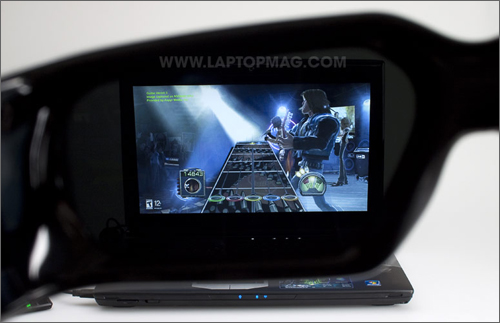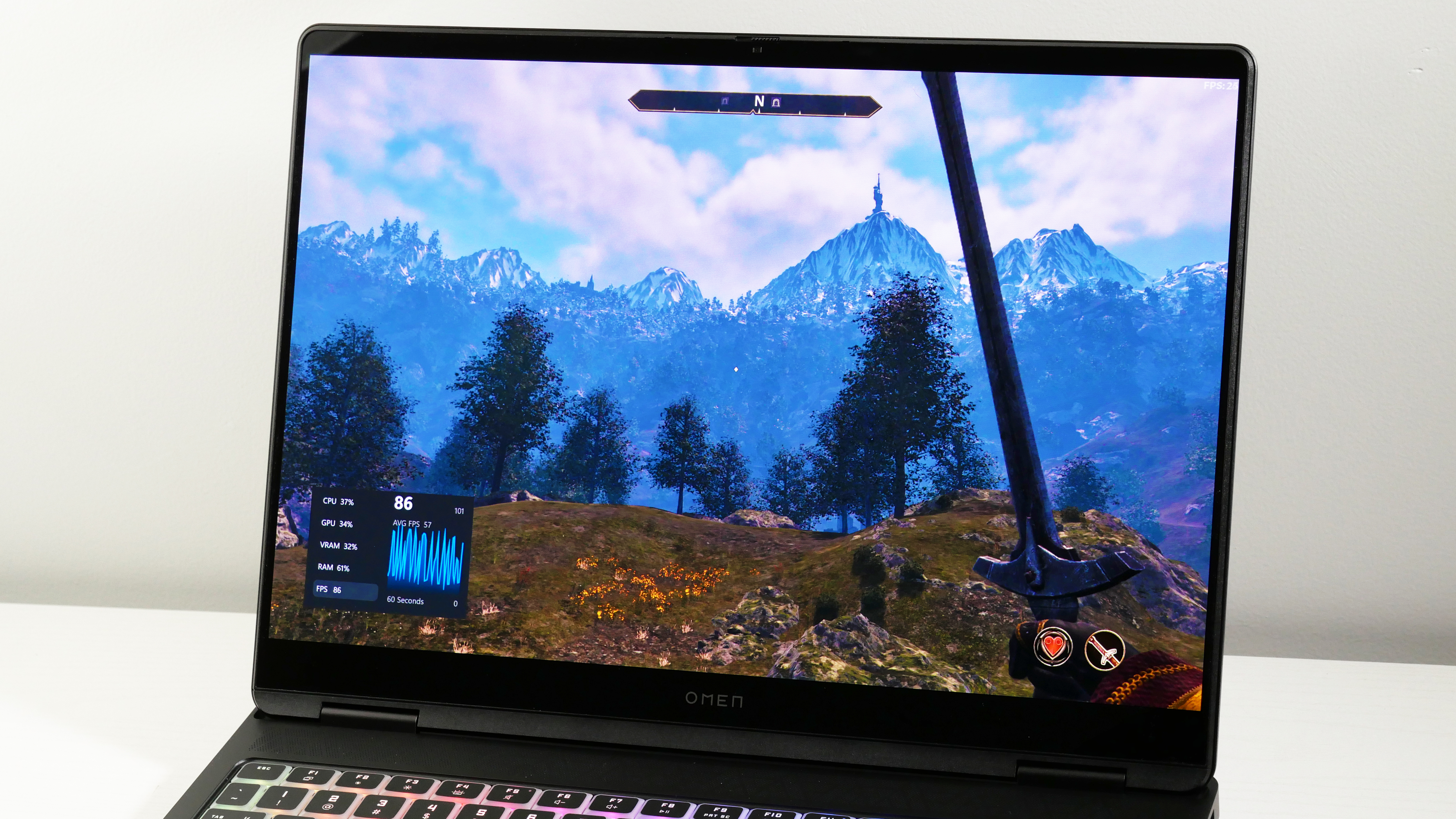Laptop Mag Verdict
This Core i7 notebook delivers an immersive 3D gaming experience for a premium price.
Pros
- +
Stylish design
- +
Fun 3D gaming
- +
Very good overall performance
- +
Gaming mouse and backpack included
Cons
- -
Worse frame rates than G51J-A1 model when using 3D
- -
Lack of 3D movie content
- -
Mediocre Wi-Fi range
Why you can trust Laptop Mag
Editor's Note:Portions of this review were taken from the review of the ASUS G51J-A1.
Would you don a pair of high-tech shades to add an extra dimension to your gameplay? As the first notebook with Nvidia's 3D Vision technology, the ASUS G51J 3D makes hundreds of titles pop off the 3D screen, from Batman: Arkham Asylum to World of Warcraft. While this $1,699 notebook lacks the full HD display and blistering frame rates of its more affordable brother, the G51J-A1, it offers a more immersive 3D experience than Acer's 5738DG 3D laptop. If they're willing to wait for other types of 3D content to become available, such as movies and Web videos, consumers who want to be the first to get their hands (and eyes) on what could be the next evolution in gaming would do well to consider the G51J 3D.
Design
Like the ASUS G51Vx and G51J-A1, the G51J 3D sports a glossy blue lid and is adorned with a backlit ASUS Republic Of Gamers logo. There is also a light bar located on the lower portion on the lid. Taken as a whole, these touches tell you that this is a serious gaming rig.
When we lifted the lid of the 14.6 x 10.3 x 1.6-inch system, our eyes were treated to a highly attractive interior. The bezel surrounding the 15.6-inch display and keyboard is glossy and reflective, making the system an immediate attention-grabber, though it's highly susceptible to fingerprints and smudges. A rubberized slip-proof (and smudge-resistant) palm rest inhabits the space below the keyboard, and has a great feel.
Above the keyboard is a speaker strip with several touch-sensitive buttons: Adjusting the gamma correction, enabling Turbo mode, disabling the touchpad, and booting into Express Gate are among the options.
Like all ASUS gaming notebooks, the G51J 3D comes with a gaming backpack and a Razer Copperhead gaming mouse; while they may not be top-of-the-line, it's still a thoughtful inclusion. The notebook also comes with Nvidia 3D glasses, as well as a pyramid-shaped receiver that plugs into one of the notebook's USB ports.
Keyboard and Touchpad
The premium look of the G51J 3D extends to the keyboard, where a white backlight gives each key a soft halo that can be raised or lowered through the use of the Fn and F3/F4 keys. Because the layout doesn't extend to the edges, some keys are undersized, such as the right Shift key and the numbers on the dedicated number pad. Nevertheless, the island-style keys are springy, which made for a solid typing experience.
As the G51J 3D is designed for gamers, there are a number of gaming-specific icons scattered across the keyboard: Arrows highlight the WASD keys (which are typically used for movement), and the 1 and 6 keys are highlighted with white circles, so you can quickly tap whatever number you need to switch weapons.

Click to enlarge
Above the keyboard is a grill that houses Altec Lansing stereo speakers, and buttons that let you cycle through visual modes (Gamma Correction, Normal, Soft, Theater, Vivid), and power settings (Battery Saving, Entertainment, High Performance, Quiet Office). To the right of those are three buttons: Express Gate (ASUS' brand of the Splashtop instant-on operating system), Power, and TouchPad Enable/Disable.
The nontextured touchpad allowed us to navigate the desktop with ease. The brushed-metal mouse buttons look cool, but felt a little stiff.
Ports and Webcam
Numerous ports and slots are available on the G51J 3D for connecting accessories and peripherals. The right side of the notebook houses the 8X DVDRW drive, two USB 2.0 ports, dual headphone jacks, and a microphone jack.
The left side has two more USB 2.0 ports, FireWire 400, eSATA, HDMI, VGA, and an ExpressCard/54 slot. The back of the G51J 3D houses an Ethernet port, while the front contains a Wi-Fi on/off switch and a 6-in-1 memory card reader.
Above the display is a 2.0-megapixel webcam that we used to chat with friends in Google Talk. Skin tones were washed out somewhat, and we saw a little motion blur when a calling buddy moved too quickly, but overall the experience was good for basic Web chatting.
Display and Audio
Although it lacks a full HD screen as on the G51J-A1, the 1366 x 768-pixel panel on the G51J 3D still exhibits great colors and definition. Horizontal viewing angles on the 15.6-inch display were excellent--nearly 90 degrees to either side--but the screen washed out a bit when we tilted it too far back or forward.
The Altec Lansing speakers delivered excellent highs when we listened to music streamed from Pandora, but bass-heavy songs (such as Jay-Z's "Empire State of Mind") didn't have their normal thump, and sounded a bit muddy in the middle. Volume was generally satisfying, but when we really wanted to crank the music, we found that the speakers didn't produce very loud sound.
3D Vision Inside
As its name suggests, the G51J 3D is capable of displaying 3D images and videos thanks to Nvidia's 3D Vision technology. Unlike the passive 3D systems in notebooks such as the Acer Aspire 5738DG (which uses simple polarized glasses), the G51J 3D uses powered shutter glasses that receive a signal from an infrared emitter that's attached to your laptop's USB port. Combined with a display that has a refresh rate of 120 Hz--a first for notebooks--it creates 3D images that are much more detailed and crisp than those on passive systems. Moreover, we saw much greater viewing angles on the G51J 3D; we could go far off-axis both horizontally and vertically.
At 1.8 ounces, the shades are more than twice as heavy than the passive ones used for the Acer system (0.7 ounces), but are not uncomfortable to wear. Nvidia includes different nose pieces, too. While there's no clip-on filter for people who wear corrective glasses, the 3D glasses can fit comfortably in front of them. On the top left side of the shades is a power button, along with a mini-USB port on the bottom to recharge them. (Nvidia says the glasses should last about 40 hours on a charge.) The glasses are a glossy black except for the tips, which are neon orange.

Click to enlarge
True 3D Gaming
Owing to Nvidia's long-time involvement with the gaming community, it's no surprise that more than 400 games can be used with its 3D Vision technology already. Nvidia lists them all here, dividing them up according to how well they mesh with 3D.
Playing games in 3D is extremely fun, and Nvidia's vast experience with gaming comes to the forefront here; whenever we launched a game, green text appeared in the lower right-hand corner of the screen, telling us what effects to turn on or off for an optimal experience. For example, in Call of Duty: World at War, we were told to use Nvidia's laser sight instead of the in-game sight. This eliminated the problem we encountered when gaming on the Acer 5738DG, when the targeting reticle would not align with the target.
In Left 4 Dead, we noticed a bit of distortion when looking at the ghost images of our teammates through walls, and lighting effects, such as the reflection of a flashlight over multifaceted surfaces, was a bit off. However, a small scroll wheel on the back of the transceiver lets you adjust the depth of your 3D experience; we found it worked best at a more modest setting.
Of the 400 games that Nvidia says are compatible with its 3D Vision technology, only 3 are deemed "Nvidia 3D Vision Ready," that is, able to take full advantage of the 3D screen. One of those games, Batman: Arkham Asylum, shows the true potential of this system: Batman's cape really seemed to flow off the screen, and steam rising from vents took on a true ethereal quality. Moreover, characters better inhabited their space on screen, giving it a true three-dimensional quality.
Gaming Performance
Unfortunately, adding 3D effects seems to impact the performance of games. Call of Duty: World at War played smoothly, if a bit slow, at 32 frames per second at 1024 x 768, and Left 4 Dead was a nice 46 fps at 1366 x 768. However, the more affordable G51J-A1 delivered 37 fps in COD at full HD (1920 x 1080) and 51 fps in Left 4 Dead at the same resolution. So you're trading off detail and frame rates for an extra dimension.
In Far Cry 2, the G51J 3D averaged 94 fps with the resolution set to 1024 x 768 and graphics set to optimal. While that's not as high as the Alienware M15x's 113 fps, it nearly tied the M17x, and scored 36 frames higher than its predecessor, the G51Vx. When we cranked the resolution to 1366 x 768 and set the graphics to Very High, the G51J 3D performed decently, notching 20 fps, which is 15 fps below the full HD G51J-A1. After disabling 3D Vision, performance improved most with the settings maxed; at 1024 x 768, the G51J 3D averaged 100 fps, but at 1366 x 768, it jumped to 47 fps.
3D Multimedia
Of course, a 3D screen isn't just for playing games; you should also be able to use it for watching 3D movies and pictures. However, this type of content is much more limited--unless you can get a bootlegged copy of Avatar. Video or photos that have not been shot in 3D can't be easily optimized for 3D. That said, ASUS includes the Nvidia 3D Player on the G51J 3D, which makes an attempt to convert videos on the fly.
Videos and photos that were filmed in 3D--such as a Nurburgring car race--were wonderfully vivid, and had great depth to them. The extra dimension greatly enhanced our viewing pleasure. However, as Nvidia pointed out, 2D videos didn't fare as well. 3D effects only work when the player is in full-screen mode, and the software didn't do a great job of converting videos to 3D. While you can tweak the settings within the player to get an optimal viewing experience, do so with caution; the further out of sync the left and right images got, the more seasick we became.
Even when the player was set up optimally, we didn't see much of an effect with 2D movies, including The Magic of Flight from the Microsoft WMV HD Content showcase, as well as an episode of Heroes. When we tried to play an AVI file of Smoking Aces, the Nvidia player kept crashing.
Plug-ins for Web sites such as YouTube and programs like Google Earth are expected in early 2010, according to Nvidia. 3D Blu-ray discs are also expected next year that will be compatible with Nvidia's 3D Vision technology, but this notebook doesn't have a Blu-ray drive.
Express Gate

Click to enlargePressing the Express Gate button on the G51J 3D allowed us to boot into the instant-on Linux operating system in 18 seconds and connect to the Web in another 15 seconds. The combined 33 seconds was 40 seconds shorter than the time it took to boot into the Windows 7 Home Premium operating system. We were also able to chat with friends over AIM and Skype, view photos, and listen to music while within Express Gate. This feature is nice to have, but we don't expect the target audience of gamers to use it very often.
Overall Performance
ASUS outfitted the G51J 3D with 4GB of RAM and a 1.6-GHz Intel Core i7-720QM processor (which we overclocked to 2.8-GHz for our performance testing). In PCMark Vantage, which measures overall system performance, this quad-core powerhouse scored 5,965. That showing is about 600 points lower than the Alienware M15x, but is still about 1,800 points above the desktop replacement category average.
Featuring the same Nvidia GeForce GTX 260M processor and 1GB of video memory as the M15x, the G51J 3D did fairly well on our graphics tests. It scored 6,779 in 3DMark06, which is about 2,600 points below the G51J-A1, but still slightly above the desktop replacement average. However, when we disabled 3D Vision, the score jumped to 11,313, meaning you'll see tremendous frame rates if you're willing to give up 3D gaming. Still, the Alienware M17x remains the champ, whose dual GTX 280M GPUs notched 13,463.
The dual 7,200-rpm, 320GB hard drives were speedy, booting to Windows 7 Home Premium in 1 minute 13 seconds. They also duplicated a 4.97GB folder of mixed media at a rate of 33.0 MBps. That's 8.1 MBps faster than the category average, and edges out the Toshiba Qosmio X505's HDD rate of 32.8 MBps.
We also tested the G51J 3D's performance by transcoding a 114MB MPEG-4 to AVI using HandBrake. Converting the file with no other open applications running in the background took 2 minutes and 53 seconds, which was about 2:15 faster than the desktop replacement average. The Nvidia GeForce GTX 260M GPU inside the G51J 3D shortened the transcode time to 2 minutes and 21 seconds when we converted the clip using vReveal, an application designed to leverage Nvidia's CUDA technology to assist in processing tasks; that's nearly identical to the M15x (2:22). We performed the same task a third time using Oxelon Media Converter, a multithreaded app that takes advantage of the G51J 3D's four cores: The program finished in just 1:02.
Battery Life and Wi-Fi
As this is a Core i7 gaming notebook, we didn't expect stellar endurance out of the G51J 3D. Its measly battery life of 1 hour and 16 minutes was 1:17 less than the category average, and even fell 18 minutes short of the Alienware M17x.
For a system with 802.11b/g/n Wi-Fi, throughput on the G51J 3D was a bit on the low side. At 15 feet from our access point, we saw throughput of 19.2 Mbps, which is below the category average of 20.0 Mbps. Likewise, throughput at 50 feet--just 10.3 Mbps--fell 6.0 Mbps short of the average.
Configurations, Software, and Warranty

Click to enlargeASUS does not currently offer any other configurations of the G51J 3D; the G51J-A1 ($1,499) has all the same specs, but trades the 3D screen for a 1920 x 1080 full HD panel.
Besides Express Gate and Windows 7 Home Premium (64-bit), the G51J-A1 comes preinstalled with Adobe Reader 9, Microsoft Office Home and Student 2007 (60-day trial), and a number of ASUS' own programs, such as ASUS LifeFrame3 (a webcam utility) and ASUS Splendid (for video enhancement). The system is covered with a two-year global warranty and 24-7 toll-free tech support.
Verdict
The ASUS G51J 3D is an exciting notebook for early adopters who want to take their gameplay to the next level. While we would've liked a higher-resolution screen--and higher frame rates--this rig is more than capable of playing the latest titles. At $1,699, it's $200 more expensive than the non-3D version, but that premium is reasonable considering the newness of the technology. Acer's $779 Aspire 5738DG does a better job of bringing 2D movies into the third dimension, but Nvidia's 3D technology is more effective, and provides better viewing angles with the included glasses. If you're a gamer, the G51J 3D is definitely worth a look.
ASUS G51J 3D Specs
| Bluetooth | Bluetooth 2.1 EDR |
| Brand | ASUS |
| CPU | 1.6-GHz Intel Core i7-720QM |
| Card Slots | 6-1 card reader, ExpressCard/54 |
| Company Website | http://usa.asus.com |
| Display Size | 15.6 |
| Graphics Card | Nvidia GeForce GTX 260M |
| Hard Drive Size | Dual 320GB |
| Hard Drive Speed | 7,200rpm |
| Native Resolution | 1366x768 |
| Operating System | MS Windows 7 Home Premium (64-bit) |
| Optical Drive | DVDRW |
| Optical Drive Speed | 8X |
| Ports (excluding USB) | Ethernet, eSATA, Dual Headphone, VGA, Microphone, HDMI, Firewire 400 |
| RAM | 4GB |
| RAM Upgradable to | 8GB |
| Size | 14.6 x 10.3 x 1.6 inches |
| USB Ports | 4 |
| Video Memory | 1GB |
| Warranty/Support | Two-year global; one-year accidental; 30-Day Zero Bright Dot/24-7 toll-free phone |
| Weight | 7.3 pounds |
| Wi-Fi | 802.11b/g/n |
Michael was the Reviews Editor at Laptop Mag. During his tenure at Laptop Mag, Michael reviewed some of the best laptops at the time, including notebooks from brands like Acer, Apple, Dell, Lenovo, and Asus. He wrote in-depth, hands-on guides about laptops that defined the world of tech, but he also stepped outside of the laptop world to talk about phones and wearables. He is now the U.S. Editor-in-Chief at our sister site Tom's Guide, where he oversees all evergreen content and the Homes, Smart Home, and Fitness/Wearables categories for the site..
